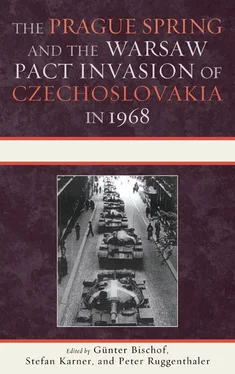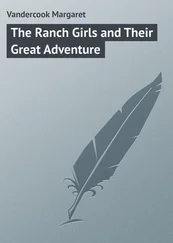86. RGANI, F. 2, op. 3, d. 130, pp. 1–26, speech by L. I. Brezhnev at the session of the plenum of the CC CPSU, 31 October 1968, reprinted in Karner et al., Dokumente , #122.
87. See the chapters by Saki Ruth Dockrill and Georges-Henri Soutou in this volume.
88. In considerable detail (including Romanian sources), see also Mastny, “Was 1968 a Strategic Watershed of the Cold War?” 169–72; on Yugoslavia, see the Tvrtko Jakovina chapter in this volume.
89. Neues Deutschland , 2 December 1989, in Deutschland Archiv 1 (1990): 137; Lutz Prieß et al., Die SED und der “Prager Frühling” 1968: Politik gegen einen “Sozialismus mit menschlichem Antlitz” (Berlin: Akademie Verlag, 1968), 17.
90. On Vladimir Putin’s visit to Prague, see Die Welt , 1 March 2006.
2
The Prague Spring and the Soviet Invasion in Historical Perspective
Mark Kramer
When turmoil engulfed many parts of the world in 1968, the Soviet Bloc was not wholly immune. A series of momentous events in Eastern Europe in 1968 marked a turning point in the Cold War. Until then, the Iron Curtain separating Communist states in the East from democratic countries in the West had seemed impermeable. The division of Europe had, ironically, been reinforced when violent rebellions erupted in several of the East Bloc countries in the first few years after Josef Stalin’s death—in Czechoslovakia and the German Democratic Republic (GDR) in June 1953, in Poznań, Poland in June 1956, and in Hungary in October 1956. Faced with violent instability and the imminent collapse of the East German regime in 1953 and the Hungarian government in 1956, Soviet leaders deployed vast numbers of combat troops to crush those challenges and restore orthodox Communist rule. The Soviet Army’s success in quelling the two uprisings consolidated the USSR’s sphere of influence in Eastern Europe and exposed the hollowness of U.S. rhetoric promising the “rollback” of communism from the region.
A very different problem arose for the Soviet Union in 1968, when Czechoslovakia embarked on a dramatic but entirely peaceful attempt to change both the internal complexion of communism and many of the basic structures of Soviet–East European relations. This eight-month-long experiment, widely known as the “Prague Spring,” came to a decisive end in the early morning hours of 21 August 1968, when hundreds of thousands of Soviet and Warsaw Pact troops invaded and occupied Czechoslovakia on behalf of “healthy forces” in the local Communist Party who set about reinstating a hard-line Soviet-style regime.
Neither the Soviet Union nor Czechoslovakia exists any longer, but the legacy of the Prague Spring and the Soviet invasion is still being felt. The reforms that took place in Czechoslovakia in 1968 under the leadership of Alexander Dubček offered the first opportunity for an East European Communist regime to earn genuine popular support. Moscow’s unwillingness to tolerate those liberalizing reforms ensured that, from then on, stability in the Eastern Bloc could be preserved only by the threat of another Soviet invasion.
That threat sufficed to hold the Bloc together for more than twenty years, even when tested by severe crises like the one in Poland in 1980–1981. But soon after Mikhail Gorbachev came along and was no longer willing to use military force in Eastern Europe, the whole Soviet Bloc collapsed. Because of the legacy of 1968, all the East European regimes still lacked the legitimacy they would have needed to sustain themselves without Soviet military backing. The invasion of Czechoslovakia saved Soviet-style communism in Eastern Europe for more than two decades, but it could not forestall the eventual demise of the Bloc.
EARLIER RESEARCH AND SOURCES
During the Cold War, historians and political scientists devoted a great deal of scrutiny to the Prague Spring and the invasion of Czechoslovakia. Countless books, monographs, and articles about the invasion and the events preceding and following it appeared in the West. For many years, all such studies had to rely exclusively or almost exclusively on open sources. Although new firsthand information about the Soviet-Czechoslovak crisis became available in the late 1970s and 1980s when some valuable memoirs and interviews appeared, these retrospective accounts were not enough to make up for the total unavailability of secret documentation in the Warsaw Pact countries. Declassified cables, memoranda, and reports from the U.S. government and from some of the West European countries helped to fill in certain gaps, but the lack of archival evidence and solid memoirs from the Soviet Bloc posed formidable problems.
By the mid-1980s the existing, open-source materials had been thoroughly mined. Without access to the Soviet and East European archives, researchers had little prospect of coming up with many additional insights. But until the late 1980s there seemed almost no chance that the East Bloc archives would ever be accessible. Given the continued sensitivity of the topic, the closed nature of the Soviet and East European societies, and the lack of any procedures in the Communist Bloc for requesting the declassification of documents (even for purely scholarly purposes), secret archival materials about the Prague Spring seemed destined to remain unavailble to scholars. Not until 1988 and 1989, when Gorbachev’s policy of glasnost (official openness) sparked bolder public discussions of Soviet foreign policy, did the opportunities for research begin to expand. Former officials—and even some active officials—in both the USSR and Eastern Europe began reassessing the whole question of the Prague Spring and the Soviet invasion. This auspicious trend gained vastly greater momentum after the collapse of East European communism in 1989 led to free elections that brought noncommunist governments to power in the former Soviet Bloc countries. The trend accelerated still further when the Communist Party of the Soviet Union (CPSU) and the Soviet state disintegrated in late 1991. Sensitive documents and firsthand accounts of the events leading up to and following the 1968 invasion, which once would have been wholly off-limits to Western (and Eastern) scholars, suddenly were available in abundance. Although many difficulties have persisted in gaining access to archival collections in Moscow and elsewhere, researchers are at last able to pore over key materials that only recently were kept under tight guard.
The recently declassified documents include stenographic accounts of all the multilateral Soviet–East European conferences in 1968; transcripts of all bilateral Soviet-Czechoslovak negotiations; transcripts of meetings of the Presidium and Central Committee of the Communist Party of Czechoslovakia ( Komunistická strana Československa , or KSČ); transcripts and supporting documents from CPSU Politburo sessions and CPSU Central Committee plenums; transcripts of meetings of the ruling organs of the Communist parties in other East European countries; the texts of secret high-level letters and messages; the detailed contemporaneous diaries of a CPSU Politburo member, Petro Shelest, who played an important role in the crisis; transcripts of high-level phone conversations; secret military directives and planning materials; reports on military exercises; memoranda and cables from the Soviet embassy in Czechoslovakia; records amassed by CPSU Central Committee departments; records from the Czechoslovak embassies in Moscow and other East Bloc capitals; reports by senior officials from other East European countries; the text of the Moscow Protocol and associated documents; and many other items. Many illuminating retrospective accounts by top-ranking participants in the crisis are also now available.
Читать дальше












